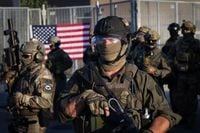In the tumultuous landscape of American immigration enforcement, few developments have captured as much attention this year as the dramatic surge in weapons spending by U.S. Immigration and Customs Enforcement (ICE). According to records cited by Popular Information and corroborated by the Federal Procurement Data System, ICE has spent a staggering $71,515,762 on new weapons and related equipment in the first nine months of President Donald Trump’s second term—an eye-popping 700 percent increase over the same period in 2024.
This enormous outlay, which spans purchases made between January 20 and October 18, 2025, marks a sharp departure from previous years. Under President Joe Biden, ICE spent just $9,715,843 on similar items during the equivalent period in 2024. Even during Trump’s first term, from 2017 to 2021, the agency’s average annual spending on these categories hovered around $8.4 million.
So, what exactly is ICE buying with all this money? The procurement records show the lion’s share went toward "small arms, ordnance and ordnance accessories manufacturing." As Popular Information explains, "small arms" covers everything from pistols and rifles to armor, explosives, and even chemical weapons. The "ordnance and ordnance accessories" category, meanwhile, includes artillery, barrels, extractors, and mounts. Notably—and raising more than a few eyebrows—ICE also purchased "guided missile warheads and explosive components" during this spree.
The bulk of the spending, officials say, was on guns and armor for field agents, a detail that underscores the increasingly militarized approach ICE has taken as its mandate expands under the Trump administration. The agency falls under the Department of Homeland Security, now led by Kristi Noem, and has seen its role—and its coffers—grow in tandem with Trump’s ambitious promise to orchestrate the "largest mass deportation program in history."
Yet, despite this rapid escalation in weaponry, ICE officials claim they still need more money from Congress to expand the use of body cameras among agents. At a congressional hearing on Monday, October 20, 2025, Shawn Byers, ICE’s deputy field office director, addressed mounting complaints about what many see as increasingly combative tactics by ICE officers. According to the Associated Press, Byers argued that, even with the recent spending spree, "additional funding is necessary to implement a comprehensive bodycam program."
As the agency’s profile and resources have grown, so too has its workforce. ICE currently estimates it has about 20,000 active agents. Assistant DHS Secretary Tricia McLaughlin recently revealed that, after an aggressive recruitment campaign on platforms like Spotify, X, Meta, YouTube, and LinkedIn, ICE has received "more than 175,000 applications" and issued "more than 18,000 tentative job offers." McLaughlin also noted that incentive processing—including signing-on bonuses—would continue even during the ongoing U.S. government shutdown, which she attributed to Congressional Democrats.
With new agents and new weapons, ICE’s expanded capacity is evident in the sheer number of people it currently detains. Official data published at the end of September 2025 shows that 59,762 individuals are being held in ICE detention centers across the country. This figure reflects the agency’s central role in Trump’s crackdown on undocumented immigrants, a campaign that has generated both fervent support and fierce opposition.
That opposition has been particularly visible on the streets. In June 2025, ICE operations in downtown Los Angeles sparked mass protests, prompting President Trump to activate the National Guard—a move that came despite the objections of California Governor Gavin Newsom, who warned that such a show of force would only escalate tensions. The protests were just one episode in a year marked by controversy and public outcry over ICE’s methods.
Indeed, ICE has faced a deluge of negative headlines in recent months. Among the most troubling revelations: the agency has arrested at least 20 American children in 2025 alone, two of whom were battling cancer at the time of their detention. Reports have also surfaced of ICE operations involving armed agents "traumatizing" mothers and children, and even firing pepper balls at a priest who was attending a demonstration.
Critics argue that the agency’s increasing reliance on force and military-style equipment has crossed a dangerous line. Ed Yohnka of ACLU Illinois, speaking to NPR, put it bluntly: "What we’re seeing is a general escalation of violence and the use of excessive force by ICE officers." Yohnka’s organization has filed a lawsuit on behalf of protesters, alleging that ICE and other federal agencies have engaged in "the dangerous and indiscriminate use of near-lethal weapons such as tear gas, rubber bullets, pepper balls, flash grenades, and other unwarranted and disproportionate tactics."
According to the lawsuit, these tactics have been deployed against individuals engaged in "cherished and protected activities"—a reference to the constitutional rights of protesters and bystanders caught up in ICE operations. The suit accuses ICE of violating those rights through its "dangerous and indiscriminate" use of force, a charge that has only gained traction as reports of aggressive encounters have proliferated.
In response to these controversies, the White House, the Department of Homeland Security, and ICE have been contacted for comment by several news outlets, including The Independent, but have yet to publicly explain the rationale behind the drastic increase in weapons spending. For now, the agency’s defenders point to the scale and complexity of its mission, arguing that robust equipment and a well-armed workforce are necessary to enforce immigration laws and ensure officer safety in volatile situations.
On the other side, critics warn that the militarization of ICE risks undermining civil liberties, traumatizing vulnerable populations, and fueling a cycle of escalation between law enforcement and the communities they police. As Ed Yohnka observed, "All over the country, federal agents have shot, gassed, and detained individuals engaged in cherished and protected activities." The debate over ICE’s tactics—and its unprecedented weapons budget—shows no sign of abating.
With nearly 60,000 people in detention, thousands of new agents on the way, and a weapons cache unlike anything in the agency’s history, ICE stands at a crossroads. The coming months will test not only the limits of its authority but also the willingness of Americans to accept the costs—financial, social, and moral—of the current approach to immigration enforcement.




